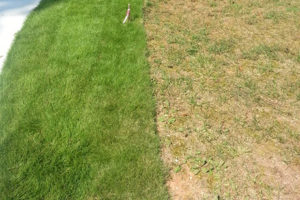
Check the Soil
It’s possible that your soil isn’t of high enough quality. If this is true, try adding extra nutrients, or even amending it by top-dressing your lawn a thin layer of screened compost. This will help to boost the greenness and beauty of your lawn, and it’s more natural than chemical fertilizers. Make sure that you aerate either annually or twice a year if you see there is any thatch or compressed dirt.
Cut the Lawn Correctly
Most lawn care experts recommend cutting no more than one-third of the total length of the grass blades each time you mow; trimming a smaller amount is even better. Very long grass is hard to mow effectively—the grass blades tend to tear rather than be sliced off cleanly by the lawnmower blade. Always aim to maintain your lawn 3 or 4 inches high lawns mowed at 3.5 or 4 inches out-compete weeds, tolerate grubs, and look just as good as lawns mowed at 2.5 inches.
Run a Mulching Lawnmower
Mulching leaves and leaving a thin layer of small leaf bits between grass blades actually can help the grass. Leaving a thick layer of whole leaves can harm the grass. Mulching leaves instead of raking saves time and keeps grass healthy.
Prevent Damage From Pets
Are you letting your dog pee on the lawn? This is a common mistake! As you might have guessed, your pet’s urine will burn the grass and leave unsightly patches in an otherwise healthy lawn. Work hard to train your dog not to pee on the lawn. If he does so anyway, wash the urine off the grass with water immediately. If you find it necessary to let your dog pee on the lawn sometimes when you cannot clean it off right away, direct him to a less visible area.
Make Sure to Water Your Grass Enough
A dried-out lawn will have a dull and subdued color. Keep this in mind especially in the heat of the summer when there can be less rainfall. Make sure to water your lawn especially carefully during this time. You need the water to soak into the soil and give your grass the opportunity for a lengthy drink to fully recover. Weekly watering, not a daily sprinkle will turn your grass into a strong green color. Watering is often a quick cure for your lawn color. Sometimes just the fact that your grass needs a drink can ruin the color of your grass.
Feed Your Lawn’s Dirt
Leading scientists recommend applying nitrogen fertilizers in the spring and fall for cool-season grasses like Kentucky Bluegrass, Fescue, and Ryegrass, and throughout the summer for warm-season grasses like St. Augustine and Bermuda since this is when the grass plant is actively growing. A lawn with a nitrogen deficiency will lose its green color and begin to turn yellow.
Hire a professional to get your lawn be the envy of the neighborhood!
Contact us (859-314-LAWN) for more information or a free instant quote!
—
 About Green & Grow
About Green & Grow
Green & Grow is a full service lawn care company specializing in lawn mowing, fertilization & weed control, aeration & seeding, insect control, and more!
> Learn More
